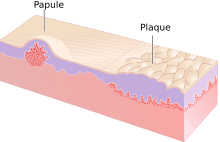Symptoms and Signs in Dermatology/Printable version
| This is the print version of Symptoms and Signs in Dermatology You won't see this message or any elements not part of the book's content when you print or preview this page. |
The current, editable version of this book is available in Wikibooks, the open-content textbooks collection, at
https://en.wikibooks.org/wiki/Symptoms_and_Signs_in_Dermatology
Macules

Macules are small skin lesions (<10 mm) characterised by change in colour of skin without any palpable elevation of skin. To be "macular" means the area of abnormality is not palpable; it can't be felt. You might find macular erythema (an area of redness) or a "macular pigmented skin lesion", which could be a junctional nevus (often referred to as a "mole") or lentigo (a kind of freckle). Being macular implies the process does not thicken the skin or represent an increase or decrease of the keratinocytes in this area.
Patches
A Patch is a macule larger than 1.0 cm. It is not elevated or palpable.
Papules

Papules are small lesions characterized by elevation of skin.
Plaques
| This page or section is an undeveloped draft or outline. You can help to develop the work, or you can ask for assistance in the project room. |
Plaques are elevated skin lesions larger than papules (> 10 mm). There may or may not be a change in the colour of the skin. Palpable lesions deeper in or below the dermis are called Nodules.
Nodules

Palpable lesions deeper in or below the dermis are called Nodules.
Vesicles

A vesicle is a small (< 10 mm) blister filled with clear fluid.
Pustules

A Pustule is a small (<10 mm) blister filled with pus.
Bullae
A Bulla is a larger (> 10 mm) blister filled with clear fluid.
Erosions

Cysts
